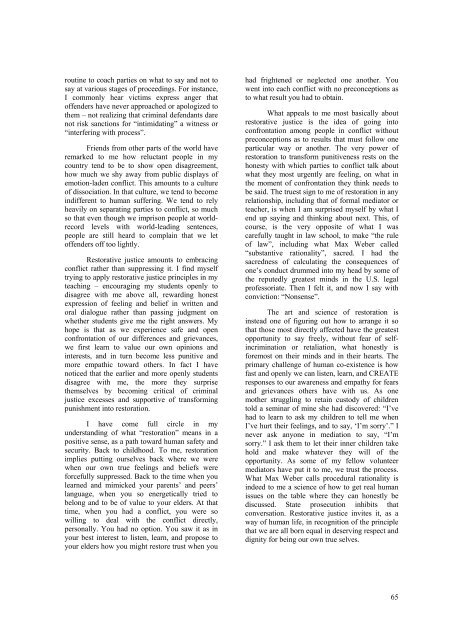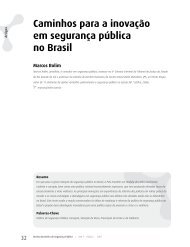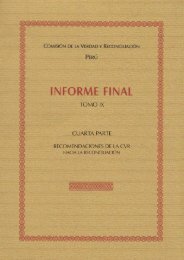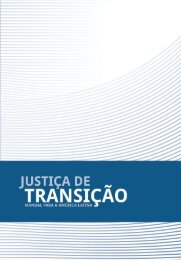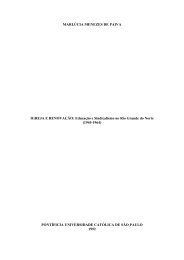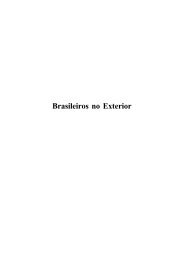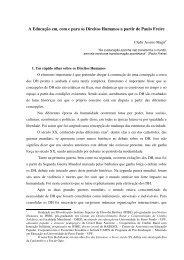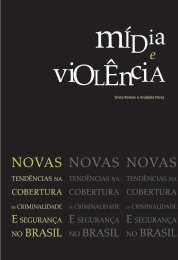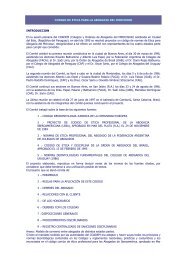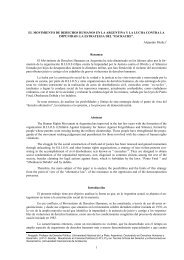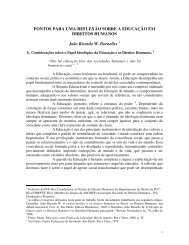ISSN 1677-1419 Ano 4, Vol. 4, Número 4 - 2003 - DHnet
ISSN 1677-1419 Ano 4, Vol. 4, Número 4 - 2003 - DHnet
ISSN 1677-1419 Ano 4, Vol. 4, Número 4 - 2003 - DHnet
You also want an ePaper? Increase the reach of your titles
YUMPU automatically turns print PDFs into web optimized ePapers that Google loves.
outine to coach parties on what to say and not to<br />
say at various stages of proceedings. For instance,<br />
I commonly hear victims express anger that<br />
offenders have never approached or apologized to<br />
them – not realizing that criminal defendants dare<br />
not risk sanctions for “intimidating” a witness or<br />
“interfering with process”.<br />
Friends from other parts of the world have<br />
remarked to me how reluctant people in my<br />
country tend to be to show open disagreement,<br />
how much we shy away from public displays of<br />
emotion-laden conflict. This amounts to a culture<br />
of dissociation. In that culture, we tend to become<br />
indifferent to human suffering. We tend to rely<br />
heavily on separating parties to conflict, so much<br />
so that even though we imprison people at worldrecord<br />
levels with world-leading sentences,<br />
people are still heard to complain that we let<br />
offenders off too lightly.<br />
Restorative justice amounts to embracing<br />
conflict rather than suppressing it. I find myself<br />
trying to apply restorative justice principles in my<br />
teaching – encouraging my students openly to<br />
disagree with me above all, rewarding honest<br />
expression of feeling and belief in written and<br />
oral dialogue rather than passing judgment on<br />
whether students give me the right answers. My<br />
hope is that as we experience safe and open<br />
confrontation of our differences and grievances,<br />
we first learn to value our own opinions and<br />
interests, and in turn become less punitive and<br />
more empathic toward others. In fact I have<br />
noticed that the earlier and more openly students<br />
disagree with me, the more they surprise<br />
themselves by becoming critical of criminal<br />
justice excesses and supportive of transforming<br />
punishment into restoration.<br />
I have come full circle in my<br />
understanding of what “restoration” means in a<br />
positive sense, as a path toward human safety and<br />
security. Back to childhood. To me, restoration<br />
implies putting ourselves back where we were<br />
when our own true feelings and beliefs were<br />
forcefully suppressed. Back to the time when you<br />
learned and mimicked your parents’ and peers’<br />
language, when you so energetically tried to<br />
belong and to be of value to your elders. At that<br />
time, when you had a conflict, you were so<br />
willing to deal with the conflict directly,<br />
personally. You had no option. You saw it as in<br />
your best interest to listen, learn, and propose to<br />
your elders how you might restore trust when you<br />
had frightened or neglected one another. You<br />
went into each conflict with no preconceptions as<br />
to what result you had to obtain.<br />
What appeals to me most basically about<br />
restorative justice is the idea of going into<br />
confrontation among people in conflict without<br />
preconceptions as to results that must follow one<br />
particular way or another. The very power of<br />
restoration to transform punitiveness rests on the<br />
honesty with which parties to conflict talk about<br />
what they most urgently are feeling, on what in<br />
the moment of confrontation they think needs to<br />
be said. The truest sign to me of restoration in any<br />
relationship, including that of formal mediator or<br />
teacher, is when I am surprised myself by what I<br />
end up saying and thinking about next. This, of<br />
course, is the very opposite of what I was<br />
carefully taught in law school, to make “the rule<br />
of law”, including what Max Weber called<br />
“substantive rationality”, sacred. I had the<br />
sacredness of calculating the consequences of<br />
one’s conduct drummed into my head by some of<br />
the reputedly greatest minds in the U.S. legal<br />
professoriate. Then I felt it, and now I say with<br />
conviction: “Nonsense”.<br />
The art and science of restoration is<br />
instead one of figuring out how to arrange it so<br />
that those most directly affected have the greatest<br />
opportunity to say freely, without fear of selfincrimination<br />
or retaliation, what honestly is<br />
foremost on their minds and in their hearts. The<br />
primary challenge of human co-existence is how<br />
fast and openly we can listen, learn, and CREATE<br />
responses to our awareness and empathy for fears<br />
and grievances others have with us. As one<br />
mother struggling to retain custody of children<br />
told a seminar of mine she had discovered: “I’ve<br />
had to learn to ask my children to tell me when<br />
I’ve hurt their feelings, and to say, ‘I’m sorry’.” I<br />
never ask anyone in mediation to say, “I’m<br />
sorry.” I ask them to let their inner children take<br />
hold and make whatever they will of the<br />
opportunity. As some of my fellow volunteer<br />
mediators have put it to me, we trust the process.<br />
What Max Weber calls procedural rationality is<br />
indeed to me a science of how to get real human<br />
issues on the table where they can honestly be<br />
discussed. State prosecution inhibits that<br />
conversation. Restorative justice invites it, as a<br />
way of human life, in recognition of the principle<br />
that we are all born equal in deserving respect and<br />
dignity for being our own true selves.<br />
65


